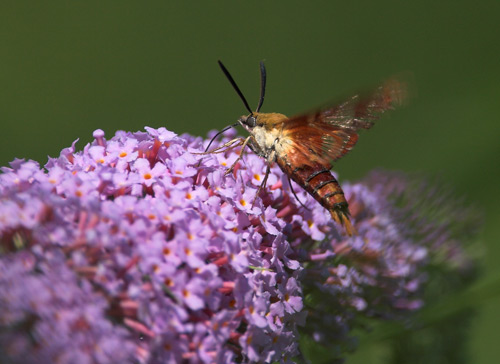
Paul Kelly manages the U of G bee yard, but Chris Earley likes to claim the honey. An interpretive biologist and education co-ordinator at the Arboretum, Earley teases: “The 70 honeybee colonies located on campus are making Arboretum honey.”
It’s a safe bet that the insects are taking advantage of the Arboretum’s flowering plants, shrubs and trees. In fact, the Arboretum takes care to ensure a plentiful menu of plants within the Gosling Wildlife Gardens to attract bees and other pollinators.
“A lot of people think pollinators and just think of bees,” says Earley. Think again. Other pollinators include numerous species of flies, butterflies, mosquitoes, moths, beetles, bats and birds — not to mention one abiotic factor: wind. “You don’t even think of them as being pollinators.”
Visit the Arboretum at the right time, he says, and you might spot a ruby-throated hummingbird dipping into a trumpet creeper’s scarlet bloom. Or you might see a hummingbird moth, so-named for the insect’s resemblance to the bird, right down to its retractile proboscis and its daytime foraging. Or any one of several species of tachinid bristle flies, whose hairy bodies collect pollen much like a bee’s does.
Goldenrod nectar is a favoured food for the locust borer, a native beetle that can attack and kill black locust trees. Glance quickly at its black and yellow stripes and you might mistake it for a wasp, says Earley. “Making yourself look a bit fearsome is a great survival strategy. It’s a pretty bug to look at.”
A larval bed in the garden contains plants that attract butterflies whose caterpillar stages require special feeding, including the pearly everlasting plant for the American lady butterfly, milkweed for the monarch, and the common hop tree for the giant swallowtail ― the largest butterfly in Canada.
The plant collection in the Gosling Wildlife Gardens is designed to motivate visitors to do similar plantings in their own backyards. It offers dozens of ideas for floral displays that appeal to pollinators, as well as woody plants and perennials that are attractive to other wildlife. A visit to the garden usually results in a positive interaction with wildlife; the area is open daily from dawn to dusk.
In addition to those plant species growing in the Arboretum, Earley offers this list of ornamentals, trees, shrubs and vegetables you and the pollinators can both enjoy.